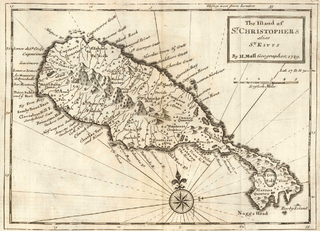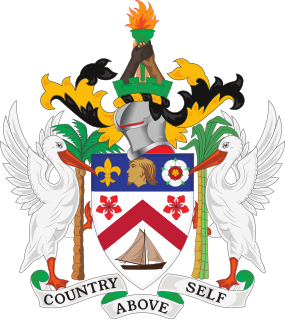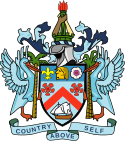
Nevis is a small island in the Caribbean Sea that forms part of the inner arc of the Leeward Islands chain of the West Indies. Nevis and the neighbouring island of Saint Kitts constitute one country: the Federation of Saint Kitts and Nevis. Nevis is located near the northern end of the Lesser Antilles archipelago, about 350 kilometres (220 mi) east-southeast of Puerto Rico and 80 kilometres (50 mi) west of Antigua. Its area is 93 square kilometres (36 sq mi) and the capital is Charlestown.

Saint Kitts and Nevis, officially known as the Federation of Saint Christopher and Nevis, is an island country in the West Indies. Located in the Leeward Islands chain of the Lesser Antilles, it is the smallest sovereign state in the Western Hemisphere, in both area and population. The country is a Commonwealth realm, with Elizabeth II as Queen and head of state. It is the only federation in the Caribbean.

Saint Kitts and Nevis have one of the longest written histories in the Caribbean, both islands being among Spain's and England's first colonies in the archipelago. Despite being only two miles apart and quite diminutive in size, Saint Kitts and Nevis were widely recognized as being separate entities with distinct identities until they were forcibly united in the late 19th century.

The politics of Saint Kitts and Nevis takes place in the framework of a federal parliamentary democracy. Saint Kitts and Nevis is an independent Commonwealth realm with Elizabeth II as its head of state, viceregally represented by a Governor-General. He acts on the advice of the prime minister, who is the majority party leader in the National Assembly, and who, with a cabinet, conducts affairs of state.
The history of Anguilla runs from the beginning of human habitation, probably via settlement from South America, through its colonization by the English in the early modern period, to the present day. Following a series of rebellions and a short-lived period as an independent republic during the 1960s, Anguilla has been a separate British overseas territory since 1980.

The British West Indies (BWI) were the British territories in the West Indies: Anguilla, the Cayman Islands, Turks and Caicos Islands, Montserrat, the British Virgin Islands, Antigua and Barbuda, The Bahamas, Barbados, Dominica, Grenada, Jamaica, Saint Kitts and Nevis, Saint Lucia, Saint Vincent and the Grenadines, British Guiana and Trinidad and Tobago. Other territories include Bermuda, and the former British Honduras. Before the decolonisation period in the later 1950s and 1960s the term was used to include all British colonies in the region as part of the British Empire. Following the independence of most of the territories from the United Kingdom, the term Commonwealth Caribbean is now used.

The Governor-General of Saint Kitts and Nevis is the representative of the monarch of Saint Kitts and Nevis, currently Queen Elizabeth II. The appointed governor-general, currently Sir Tapley Seaton, lives in Government House, Basseterre, which serves as his official residence.

Saint Christopher-Nevis-Anguilla was a British colony in the West Indies from 1882 to 1983, consisting of the islands of Anguilla, Nevis, and Saint Christopher. From 1882 to 1951, and again from 1980, the colony was known simply as Saint Christopher and Nevis. Saint Christopher and Nevis gained independence in 1983 as the Federation of Saint Kitts and Nevis, while Anguilla would remain a British overseas territory.

The term British West Indies refers to the former English and British colonies and the present-day overseas territories of the United Kingdom in the Caribbean.

The National Assembly is the unicameral legislative assembly that, together with the Queen of Saint Christopher and Nevis, forms the Parliament of Saint Kitts and Nevis.
West Indies Associated States was the collective name for a number of islands in the Eastern Caribbean whose status changed from being British colonies to states in free association with the United Kingdom in 1967. These states were Antigua, Dominica, Grenada, Saint Christopher-Nevis-Anguilla, Saint Lucia, and Saint Vincent.

Simeon Daniel was the first Premier of Nevis.

The following outline is provided as an overview of and topical guide to Saint Kitts and Nevis:

The Monarchy of Saint Kitts and Nevis is a constitutional monarchy in which a monarch is head of state of Saint Kitts and Nevis. The present monarch is Elizabeth II, who is also Sovereign of the other Commonwealth realms. The Queen's constitutional roles are mostly delegated to the Governor-General of Saint Kitts and Nevis. Royal succession is governed by the English Act of Settlement of 1701, which is part of constitutional law.

The Constitution of Guyana is the highest governing document in the Republic of Guyana. It came into effect on October 6, 1980, replacing it constitution enacted in 1966 upon its independence from the United Kingdom. The current Constitution of Guyana contains 12 chapters that are further divided into 232 articles. It also contains a preamble and an oath. Since its 1980 enactment, it has gone through multiple amendments.

The Republic of Anguilla was a short-lived, unrecognised independent state on the island of Anguilla. It lasted from 11 July 1967 until 19 March 1969, when British control was re-established.
Sir Frederick "Fred" Albert Phillips CVO was a Kittitian politician and jurist who served as the first black Governor of Saint Christopher-Nevis-Anguilla from February 27, 1967 to 1969.

The Constitution of the British Virgin Islands is a predominantly codified constitution documented primarily within the Virgin Islands Constitution Order, 2007 a statutory instrument of the United Kingdom. The 2007 Constitution was the fourth written constitution of the British Virgin Islands, and superseded the 1976 constitution. In addition to the constitution itself a number of the constitutional powers of the British Virgin Islands government are specified a "letter of entrustment" from the Foreign and Commonwealth Office which delegates powers to the British Virgin Islands government to represent itself in certain external affairs.
Kittitian and Nevisian nationality law is regulated by the 1983 Constitution of Saint Kitts and Nevis, as amended; the Saint Christopher and Nevis Citizenship Act of 1984, and its revisions; and various British Nationality laws. These laws determine who is, or is eligible to be, a national of Saint Kitts and Nevis. Kittitian and Nevisian nationality is typically obtained either on the principle of jus soli, i.e. by birth in Saint Kitts and Nevis; or under the rules of jus sanguinis, i.e. by birth abroad to parents with Kittitian and Nevisian nationality. It can be granted to persons with an affiliation to the country, or to a permanent resident who has lived in the country for a given period of time through naturalisation. There is also, currently a program in Saint Kitts and Nevis for persons to acquire nationality through investment in the country. Nationality establishes one's international identity as a member of a sovereign nation. Though it is not synonymous with citizenship, for rights granted under domestic law for domestic purposes, the United Kingdom, and thus the commonwealth, have traditionally used the words interchangeably.














